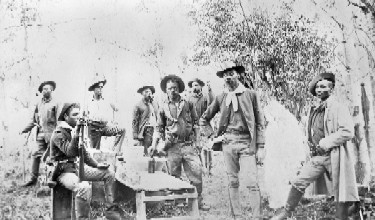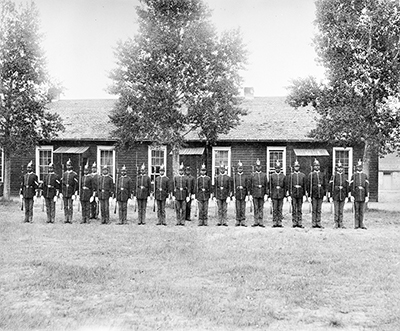By Anthony Wood
The Buffalo Soldier Era

The African American military tradition reaches back to colonial times. However, as a matter of official recognition, the first detachment of all-black soldiers fought for the Union Army during the latter years of the Civil War. [1] Between 1866 and 1869, the newly constituted United States Armed Forces reconfigured the original companies into four military units—the 9th and 10th Calvary and the 24th and 25th Colored Infantry Regiments. Soon afterward they began their deployment in the American Southwest protecting settlers. Throughout the 1870s and 80s, in addition to their regular duties of manning forts and defending military outposts and frontier towns, the two infantry regiments performed public service jobs such as stringing telegraph wire across a vast expanse of Texas, New Mexico, and Arizona. The 9th and 10th Calvary Regiments fought Native American nations in all-out campaigns and brief skirmishes, earning them a certain amount of renown in the western territories. [2]
Beginning in the late 1880s, the 24th and 25th Infantry Regiments deployed north to the Dakotas and Montana Territory. [3] Over the next decade, Forts Shaw, Maginnis, Custer, Keogh, Assinniboine, Harrison, and Missoula became a temporary home for the Buffalo Soldiers. It was during this time that the 25th captured the American public’s imagination as an experimental bicycle division. Seeking to replace expensive horses with cheaper forms of transportation, the military personnel of the 25th performed patrols and other duties on two wheels. The experiment gained national attention when, in 1896, these African American cyclists embarked upon a remarkable journey from Missoula to St. Louis. [4]

In 1898 the Spanish-American War marked a temporary end to Buffalo Soldiers’ deployment in the West. All four regiments were posted to active combat duty. The 10th Calvary became renowned for its gallant charge up San Juan Hill alongside Theodore Roosevelt’s Rough Riders, while the other regiments equally distinguished themselves in less celebrated clashes with the enemy. In fact, both the 10th and the 24th played a significant role in the capture of San Juan Hill as well as in the Battle for El Caney. [5] After the Cuban campaign, the regiments were sent to repress guerilla fighters in the Philippines, a highly controversial operation that would last for years. [6] The wars in Cuba and the Philippines had a lasting impact on the shape of Montana’s African American communities. Many soldiers returned to Montana weary and unwell, and chose not to reenlist with the Army, but instead make the state their permanent home.
Full Text With Citations (PDF)
